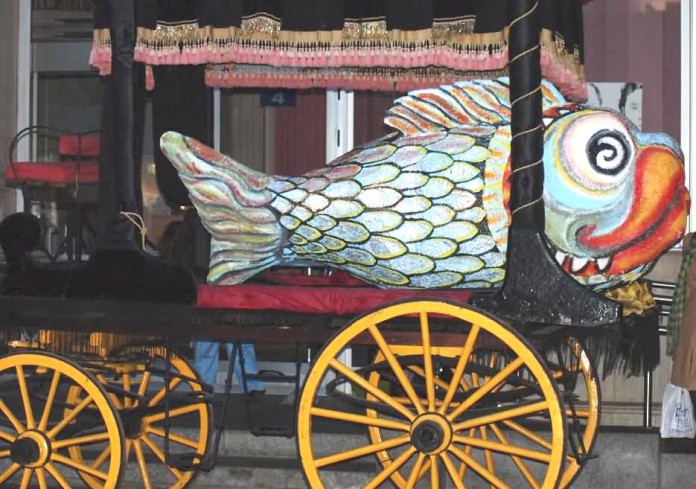By David Jackson
It’s a bit of a bizarre custom. The mad heady days of carnival are finished off by the solemn burial of the sardine. But why do the Spanish bury anything after Carnival, and why a sardine in particular?
To answer that, we must take a step backwards in time, to a time when superstition and religion ruled.
The entierro de la sardina is a ceremony that winds up Carnival across Spain and its South American former colonies. The burial (the entierro) is a carnival parade that parodies the funeral rites.
A cavalcade of clowns and revellers accompany a symbolically grotesque figure, which is usually a sardine. The sardine is taken to a spot outside of town and buried amongst much cat calling and mock mourning. The ceremony is normally held on (or in our modern hard-working times, on the handiest weekend to) Ash Wednesday.
It’s a symbolic burial of the past. The ceremony is stripping away the past, in a socially established ritual of chaos, burning out the mayhem of carnival and the long winter months, and ushering in from the ashes a new year, a society reborn and serious once again, ready to face the hardships of the future.
Or at least that’s the theory of Professor Carmen Barreto, whose 1993 PhD thesis on Spanish carnival made many sociologists pause to think.
The ceremony in its current form is held to have begun with Charles III shortly after he ascended to the throne of Spain in 1759. King Charles was a solemn believer in tradition and encouraged local fiestas before Lent on the condition that villagers buckled down to their religious duties afterwards.
The story runs that on one Ash Wednesday the King ordered the last day of the fiesta in Madrid to be marked with an enormous festival at which free fish – sardines – would be given out to all, and all meat was to be buried, symbolising that no meat could be eaten for the next 40 days.
However, it being a hot day, and Madrid being a long way from the sea, when the cooks opened the crates of fresh sardines the stench made everyone ill.
King Charles furiously ordered the fish instead of the meat to be buried in the Casa del Campo park where the fiesta was being held. The attendees leapt to work with gusto, and the fiesta carried on all day – but with the revellers consuming meat instead of the fish, by Royal Dispensation.
In fact, it was such a success that it became an annual tradition that quickly spread elsewhere in Spain.
What we do know is that many Spanish festivals end with the symbolic destruction of a figure that represents all the vice and fun that accumulated over the course of the fiesta. For example, many towns used to hold the Fiesta del Judas, a ceremony in which Judas of Iscariot is burnt or hacked apart. Usually held around Easter week, the ceremony is held on other days of the year elsewhere.
The burial ceremony came to replace older Spanish customs held to mark the end of the winter. Many ancient Mediterranean cultures held symbolic ceremonies to welcome the arrival of Spring, and especially good luck rituals to ensure the fishermen, who could now venture back out to sea without fear of the winter storms, had good hauls.
February 24 was called the day of the Halcyons by Ptolemy in his Phaseis. This was held to be the day that the Halcyons, a mythical bird with the power to calm the waves of the sea, would head out to the Mediterranean to build their floating nests, and thus end the winter storms. Incidentally, that’s where we get the expression “those halcyon days” from, those period of quiet gentle days of our youth.
It thus marked the beginning of the Spring fishing season.
The tradition was picked up and spread by the Arabs, who called the days between February 21 and 24 the Al riyab Al-jutt’afiyya – the winds of calm – a tradition that the medieval Spanish would adopt, calling it the winds of the Quelidonios.
These early Spring traditions would eventually become absorbed by Christianity. In the same way that the Anglican Church still celebrates Harvest Thanksgiving, a ceremony to be grateful for the harvest bounty of Autumn, these Spring traditions would try to ensure a good bounty and good luck for the season ahead.
The Inquisition, never a very understanding bunch of men, did their best to eliminate such festivals, but failed. And the Spanish Enlightenment of the late 18th century would allow these ancient traditions to be resurrected under a new name and a new veneer of respectability.
People tend to confuse the burial with Ash Wednesday. That marks the start of Lent, the forty days of abstinence before Easter. The “Ash” of Wednesday comes from the tradition of burning the carefully kept palm leaves of the previous year’s Palm Sunday, which marks the start of Easter.
But Carnival is always held in the fortnight before Lent starts. It’s a way of letting your hair down after the hard winter and before the serious business of Lent begins.
The ceremony calls together the town and says: “Look, we’ve all had our fun, now let’s settle down and get back to work”.
Unless you’re Murcian, of course. They bury the sardine at the beginning of the carnival, and there it represents the contrary: Order and Work is buried away out of sight so it isn’t shocked by the Carnival. Which mindset is why their Carnivals are considered to be the best in Spain. I’ve never had a bad one there yet.


























